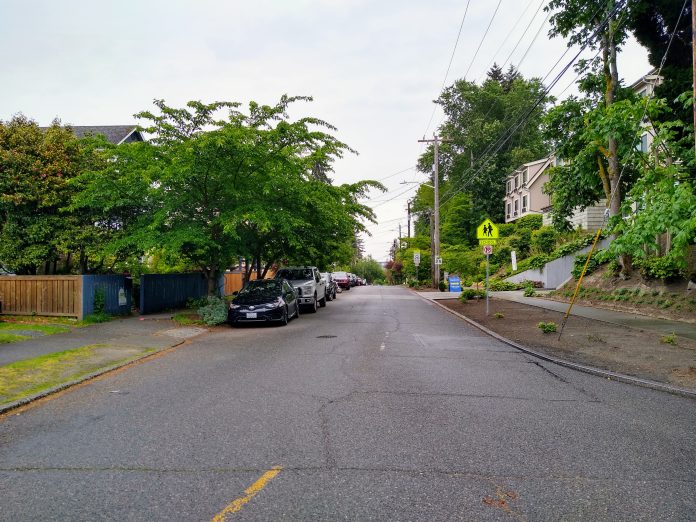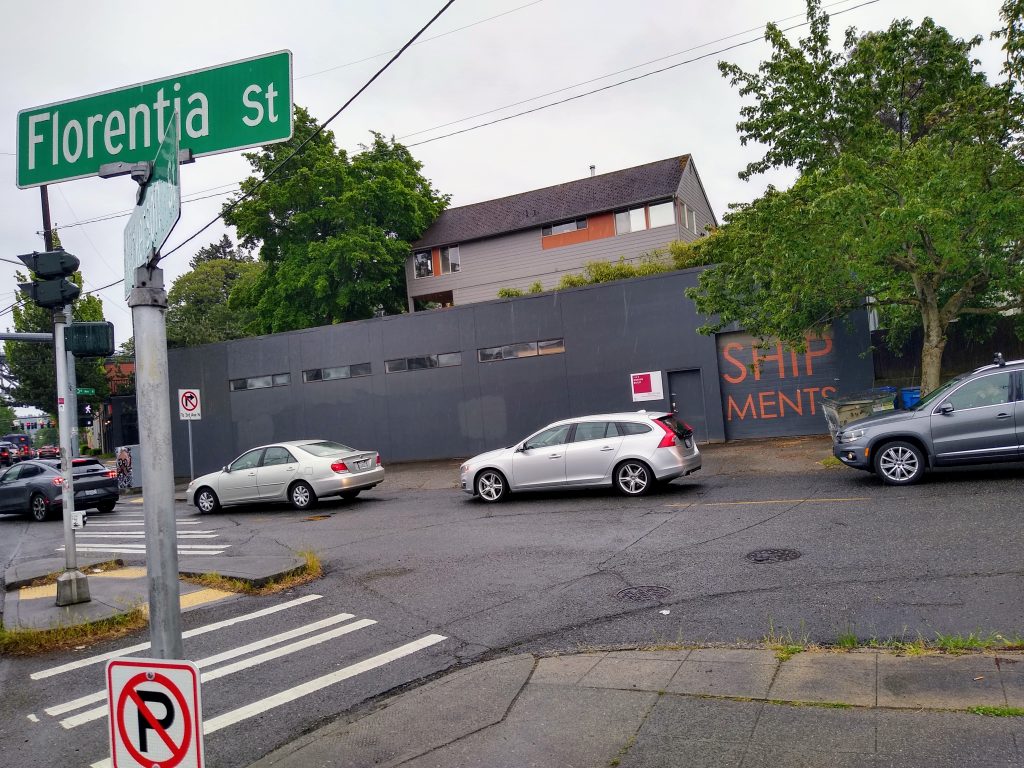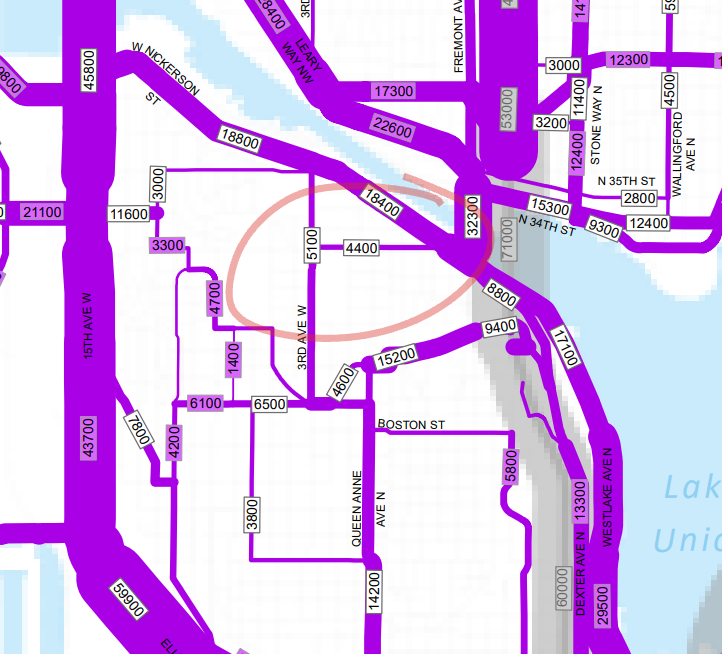
Residents near Florentia Street, on the north slope of Queen Anne hill, have an urgent but common complaint: people drive too fast on their street. The street, which runs just seven blocks between Nickerson Street and 3rd Avenue W, is used as a cut-through and as a signed route for people to get to Fremont from elsewhere in Queen Anne. Florentia is designated by the City of Seattle as a “collector arterial,” the lowest of its three designations for arterial streets, and only carried around 4,400 vehicles per day pre-pandemic, according to the Seattle Department of Transportation (SDOT). The speed limit is 25 miles per hour like most arterial streets in the city. Because it’s an arterial, there is a painted center line in the middle of the street. Residential streets don’t get a similar treatment.
In addition to pushing for traffic calming measures, some nearby residents have tried a different path: removing Florentia’s designation as an arterial street. Councilmember Andrew Lewis, who has represented Queen Anne since 2020, proved amenable to this idea, and last year, he put forward the proposal in the annual amendment process for the city’s Comprehensive Plan. “I’m really, really excited to see this moving forward, and see this space on Florentia get reclaimed for more equitable access for pedestrians and bicyclists,” Lewis said before a public hearing on the issue last July.

Lewis told his council colleagues that the aim of the amendment was to prompt physical changes to the roadway. “This has been a very common complaint from residents from the time that I was doorbelling here during my campaign, and into office, from residents who have been concerned about the safety hazards posed by cars that respond to the incentives on the street, that really speed through this zone that is flanked by a lot of residential houses. This is really a great opportunity to demonstrate how an arterial that is positioned like this can really be a better neighborhood asset, if we return it back to the neighborhood and turn it into more of a local, residential street.”
Last year, Lewis spearheaded a proposal to allocate revenue generated from increasing the city’s commercial parking tax to additional transportation safety projects, in an effort to reverse the worsening trendline seen in recent years when it comes to citywide traffic fatalities. But a street like Florentia would likely never be prioritized for that pot of funding within SDOT because there are so many other locations in need of traffic calming and other infrastructure improvements. In that way, this proposal was a clear attempt to circumvent that normal prioritization process.
The Florentia proposal was unanimously approved by City Council last year, but only as a nonbinding resolution. Both the Seattle Planning Commission and the Office of Planning and Community Development (OPCD) gave their approval to the amendment. However, OPCD provided a big caveat, which is that they wouldn’t recommend final adoption of the amendment until SDOT had completed a full analysis of the proposal.

SDOT is now signaling that this change will take much longer than envisioned because the department wants to take a broader look at similar streets like this around the city. “Because there are significant challenges with potential reclassification of Florentia in isolation from the rest of the street network, and because reclassification is not likely to address the residents’ desire for specific types of traffic calming in the nearer term, SDOT and OPCD recommend a citywide review of collector arterial and high volume non-arterial streets as part of the Seattle Transportation Plan which will inform the Transportation Element for the Comp Plan Major Update that will be subject to Council review and approval in 2024,” SDOT wrote in an email to Councilmember Lewis’s office in May.
SDOT points to Seattle Fire Department emergency response as being a large hurdle when reevaluating arterial streets anywhere in the city. “Due to the connectivity provided by the network of arterials, all arterials are considered by SDOT and SFD to be part of the emergency response network, along with selected non-arterial streets,” SDOT said. The fire department is also consulted when SDOT proposes adding infrastructure like speed cushions or raised crosswalks. “Reclassification of Florentia from a collector arterial to a non-arterial would not necessarily eliminate the barriers to adding traffic calming elements to Florentia, which include the high volume of SFD responses along Florentia that could result in the street being included in the emergency response network as a non-arterial SFD route. Nor would a change in classification likely result in Florentia becoming a priority for traffic calming because it does not have a significant crash history compared to other streets in the network, and the street is in an area of ‘Lowest Disadvantage’ as measured by the City’s Racial and Social Equity Composite Index.”
Douglas Migden, a member of the Seattle Bicycle Advisory Board and one of the residents nearby pushing for this change, found SDOT’s explanation of a delay unacceptable. “I’ve lost track there have been so many delays. I and other residents of Florentia Street/ QA have been working on this issue for at least three years. There is no question that we were definitively told the designation would be changed in the 2022 Comp plan by this March,” he wrote in response to Councilmember Lewis’s office breaking the news.
“Florentia Street is a narrow street with no shoulder,” Migden wrote. “Cars are routinely parked on Florentia such that they are sticking out into the street. The street is inappropriately used as a cut-through for Nickerson Street traffic and this is unacceptable. Cars are frequently flying down this street – particularly west to east- with many smaller streets intersecting it coming off of Upper Queen Anne Hill. Big trucks also not infrequently use the street and shake our houses.”
Lewis is not ready to give up on this specific battle. “I strongly support moving forward with the amendment on the original schedule and am currently exploring options to make this happen,” he wrote in response to questions from The Urbanist. “I believe Florentia to be a redundant arterial given the nearby access to Nickerson and the lack of a Metro transit route. Residents of the neighborhood surrounding Florentia have been demanding action to address unsafe conditions on Florentia for years. This redesignation is the first step in a longer process to realize important traffic calming and pedestrian improvements to better integrate Florentia into the surrounding community. I will keep the public informed as SDOT and Council Central Staff advise on a path forward to realize the original timeline.”
There are quite a few arterial streets in Seattle with lower daily traffic volumes than this stretch of Florentia. In fact, The Urbanist found that SDOT data shows over one hundred arterial street segments that see lower daily volumes of traffic, including a stretch of Mount Baker Boulevard near Franklin High School that saw fewer than 500 vehicles per day in 2017 and is also classified as a collector arterial. That street is one block south of a minor arterial, S McLellan Street, essentially serving as a poster child for redundant arterials. Of course, streets with high volumes of cars should also be safe and have a design that maximizes safety for all users, and people who live on streets deemed “residential” should not be seen as more deserving of a safe environment.

When asked about SDOT’s proposal to look at all arterials with traffic volumes similar to Florentia, Lewis was circumspect about opening the door to improvements elsewhere in District 7. “I am always happy to look at redundant arterials and returning them to the public for safer uses,” Lewis said. “But, I hope we can have a phased-in approach allowing us to take action on Florentia now while working toward other safety improvements in the neighborhood.”
The Seattle Transportation Plan, which safety advocates have already voiced concerns about in regards to elements that suggest a scaling-back of existing city plans like the 2014 bicycle master plan, could be an opportunity to re-examine some of these facilities that are usually treated as static and unchangeable. It is clear that if this change is made, the city shouldn’t stop at Florentia Street. What’s less clear is whether the Seattle Process that appears to be asserting itself in this situation will ultimately lead anywhere productive.
Ryan Packer has been writing for The Urbanist since 2015, and currently reports full-time as Contributing Editor. Their beats are transportation, land use, public space, traffic safety, and obscure community meetings. Packer has also reported for other regional outlets including BikePortland, Seattle Met, and PubliCola. They live in the Capitol Hill neighborhood of Seattle.

